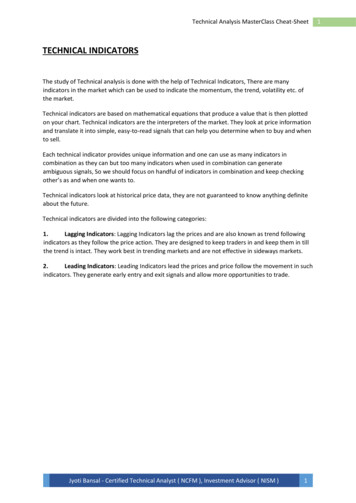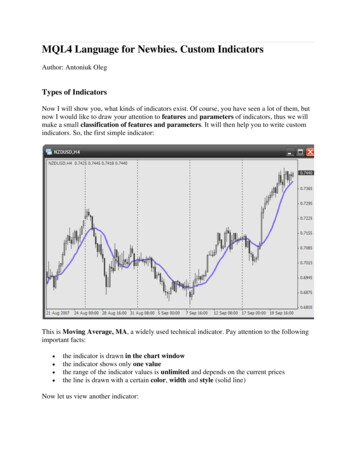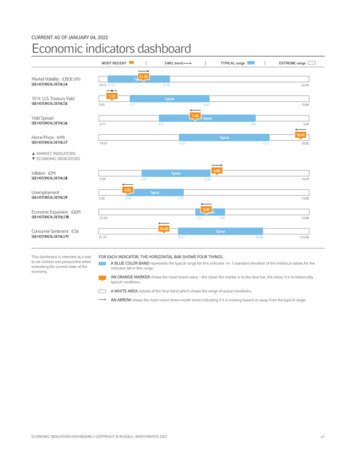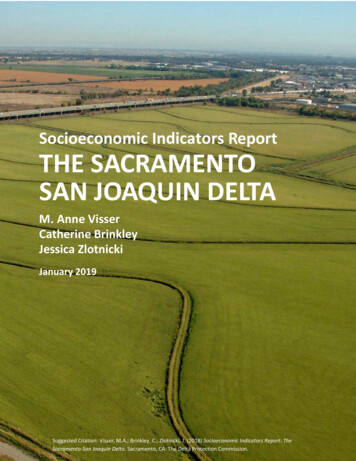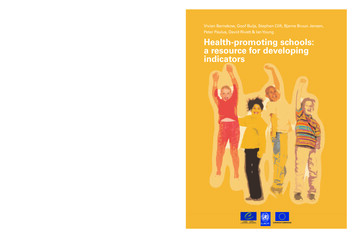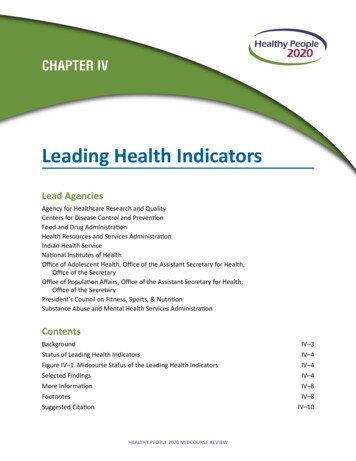
Transcription
CHAPTER IVLeading Health IndicatorsLead AgenciesAgency for Healthcare Research and QualityCenters for Disease Control and PreventionFood and Drug AdministrationHealth Resources and Services AdministrationIndian Health ServiceNational Institutes of HealthOffice of Adolescent Health, Office of the Assistant Secretary for Health,Office of the SecretaryOffice of Population Affairs, Office of the Assistant Secretary for Health,Office of the SecretaryPresident’s Council on Fitness, Sports, & NutritionSubstance Abuse and Mental Health Services AdministrationContentsBackgroundStatus of Leading Health IndicatorsFigure IV–1. Midcourse Status of the Leading Health IndicatorsSelected FindingsMore InformationFootnotesSuggested CitationHEALTHY PEOPLE 2020 MIDCOURSE REVIEWIV–3IV–4IV–4IV–4IV–8IV–8IV–10
IV–2HEALTHY PEOPLE 2020 MIDCOURSE REVIEWContents—ContinuedTable IV–1. Leading Health IndicatorsTable IV–2. Midcourse Progress for Leading Health IndicatorsTable IV–3. Midcourse Health Disparities for Population-basedLeading Health IndicatorsMap IV–1. Adults (50–75 years) Who Received Colorectal Cancer Screening Based onMost Recent Guidelines, by State: 2014Map IV–2. All Infant ( 1 year) Deaths, by State: 2013Map IV–3. Total Preterm Live Births ( 37 completed weeks of gestation),by State: 2013Map IV–4. Adults (18 years) Who Met Guidelines for Aerobic andMuscle-strengthening Physical Activity, by State: 2013Map IV–5. Adult (20 years) Obesity Based on Self-reported Weight and Height,by State: 2013Map IV–6. Knowledge of Serostatus Among HIV-positive Persons (13 years),by State: 2012Map IV–7. Students Who Graduated From High School 4 Years AfterStarting 9th Grade, by State: 2012–2013Map IV–8. Adults (18 years) Who Engaged in Binge Drinking in the Past 30 Days,by State: 2010–2013Map IV–9. Adult (18 years) Cigarette Smoking, by State: 2013Map IV–10. Adolescent (grades 9–12) Cigarette Smoking in the Past 30 Days,by State: 2013HEALTHY PEOPLE 2020 MIDCOURSE –26IV–27IV–28IV–29IV–30IV–31IV–32
Chapter IV Leading Health IndicatorsIV–3BackgroundFor four decades, Healthy People has provided acomprehensive set of 10-year national goals andobjectives for improving the health of all Americans.Healthy People 2020, the most recent iteration, tracks thecountry’s health through more than 1,200 objectives thatspan 42 topic areas.The Leading Health Indicators are a select subset of 26Healthy People 2020 objectives chosen to communicatehigh-priority health issues and challenges. They addressdeterminants of health that promote quality of life,healthy behaviors, and healthy development across alllife stages. The indicators are used to assess the healthof the country, facilitate collaboration across sectors, andmotivate action to improve health at the national, state,and community levels.The Leading Health Indicators were selected andorganized using a “Health Determinants and HealthOutcomes by Life Stages” conceptual framework. Thisapproach was intended to draw attention to bothindividual and societal determinants that affect thepublic’s health and contribute to health disparities frominfancy through old age, thereby highlighting strategicopportunities to promote health and improve quality oflife for all Americans. The selection process was led bythe Healthy People 2020 Federal Interagency Workgroup(FIW). In selecting the indicators, the FIW took intoconsideration recommendations from the Institute ofMedicine of the National Academy of Sciences and theSecretary’s Advisory Committee on National HealthPromotion and Disease Prevention Objectives for2020. For more information on the development andframework see “More Information” below.Leading Health Indicator TopicsThe Leading Health Indicators are organized into 12topics. These topics are described briefly below, andreferences are provided for readers interested in furtherinformation about their public health significance.Access to Health Services. Barriers to accessing healthservices, such as lack of availability, high cost, and lackof medical insurance, lead to unmet health care needs,delays in receiving needed care, inability to obtainpreventive services, and preventable hospitalizations.1Clinical Preventive Services. Services such as routinedisease screening and scheduled immunizations preventillnesses and detect diseases in their earlier, moretreatable stages, reducing the risk of illness, disability,early death, and medical care costs.2Environmental Quality. Approximately one-quarterof the global disease burden is due to modifiableenvironmental factors, which include exposure to toxicsubstances and hazardous wastes in the air, water, soil,and food.3Injury and Violence. Intentional and unintentionalinjuries are critical public health concerns in the UnitedStates. They include homicide; intimate partner,sexual, and school violence; child abuse and neglect;suicide; motor vehicle crashes; and unintentional drugoverdoses.4Maternal, Infant, and Child Health. Addressing thehealth needs of women before, during, and afterpregnancy helps to improve not only their health butalso their children’s health. Healthy birth outcomes andearly identification and treatment of health conditionsamong infants can prevent death or disability and enablechildren to reach their full potential.5Mental Health. Mental health is a component of aperson’s well-being, healthy family and interpersonalrelationships, and the ability to live a full and productivelife. Mental health disorders have a serious impact onphysical health and are associated with the prevalence,progression, and outcome of chronic diseases such asdiabetes, heart disease, and cancer.6Nutrition, Physical Activity, and Obesity. Good nutrition,physical activity, and a healthy body weight can helpdecrease the risk of developing serious health conditions,such as high blood pressure, high cholesterol, diabetes,heart disease, stroke, and cancer. In addition, to manageexisting health conditions to improve quality of life,the 2015–2020 “Dietary Guidelines for Americans”emphasize following a healthy eating pattern, engaging inregular physical activity, and achieving and maintaining ahealthy weight.7Oral Health. Oral diseases include dental caries (cavities),periodontal (gum) disease, cleft lip and palate, oral andfacial pain, and oral and pharyngeal (mouth and throat)cancers. Oral diseases, particularly gum disease, havebeen linked to chronic diseases such as diabetes, heartdisease, and stroke. Many oral diseases can be preventedwith regular dental care.8Reproductive and Sexual Health. Reproductive andsexual health covers a broad range of health needs fromadolescence forward, including the reproductive system,sexually transmitted diseases (STDs), HIV, and fertility.Untreated STDs can lead to serious long-term health
IV–4HEALTHY PEOPLE 2020 MIDCOURSE REVIEWconsequences, especially for adolescent girls and youngwomen. These include reproductive health problems andinfertility, fetal and perinatal health problems, cancer, andfurther sexual transmission of HIV and other STDs.9Social Determinants. Individual and population healthare affected by a range of personal, social, economic,and environmental factors. For example, access to parksand safe sidewalks is associated with physical activityin adults, and education is associated with improvedhealth and quality of life and health-promoting behaviors.Although education is the Leading Health Indicator forthis topic, many Healthy People 2020 objectives addresssocial determinants as a means of improving populationhealth.9Substance Abuse. Substance abuse—involving drugs,alcohol, or both—is associated with a wide rangeof detrimental social conditions, including familydisruptions, financial problems, lost productivity, failurein school, domestic violence, child abuse, and crime.Substance abuse contributes to a number of negativehealth outcomes and public health problems, includingcardiovascular conditions, pregnancy complications,teen pregnancy, HIV/AIDS, STDs, motor vehicle crashes,homicide, and suicide.10,11Tobacco. Tobacco use is the leading cause of preventabledisease, disability, and death in the United States. Moredeaths are caused each year by tobacco use than fromHIV, illegal drug use, alcohol use, motor vehicle injuries,suicides, and homicides combined. Tobacco use causesseveral forms of cancer, heart disease, stroke, lungdiseases, pregnancy complications, gum disease, andvision problems.12,13Status of Leading Health IndicatorsFigure IV–1. Midcourse Status of Leading Health IndicatorsTotal Objectives: 26Measurable Objectives: 26Getting worse 11.5% (n 3)Little or nodetectablechange26.9% (n 7)MeasurableDevelopmental50.0% 100.0%(n 2) (n 26)Target met orexceeded30.8% (n 8)Improving30.8% (n 8)All 26 of the Leading Health Indicators were measurableHealthy People 2020 objectives15,16 at midcourse(Figure IV–1, Table IV–1). The midcourse status of theseobjectives (Table IV–2) was as follows:Selected Findings 8 objectives had met or exceeded their 2020 targets, The proportion of persons under age 65 with medical17 8 objectives were improving,18 7 objectives had demonstrated little or no detectablechange,19 and 3 objectives were getting worse.20Access to Health Servicesinsurance (AHS-1.1) increased from 83.2% in 2008 to86.7% in 2014, moving toward the 2020 target (TableIV–2).» In 2014, there were statistically significantdisparities by sex, race and ethnicity, education,family income, disability status, and geographiclocation in the proportion of persons under age 65with medical insurance (AHS-1.1, Table IV–3).
Chapter IV Leading Health Indicators There was little or no detectable change (76.3% in2007 and 76.5% in 2012) in the proportion of personswith a usual primary care provider (AHS-3, TableIV–2).» In 2012, there were statistically significantdisparities by sex, race and ethnicity, education, andfamily income in the proportion of persons with ausual primary care provider (AHS-3, Table IV–3). Thedisparity by geographic location was not statisticallysignificant.Clinical Preventive Services The age-adjusted proportion of adults aged 50–75who had received a colorectal cancer screening basedon the most recent guidelines (C-16) increased from52.1% in 2008 to 58.2% in 2013, moving toward the2020 target (Table IV–2).» In 2014, the age-adjusted proportion of adults aged50–75 who received a colorectal cancer screeningbased on the most recent guidelines varied by state(Map IV–1).21» In 2013, there were statistically significantdisparities by race and ethnicity, education, familyincome, disability status, and geographic location inthe age-adjusted proportion of adults aged 50–75who had received a colorectal cancer screeningbased on the most recent guidelines (C-16, TableIV–3). The disparity by sex was not statisticallysignificant. The age-adjusted proportion of adults aged 18 andover with hypertension whose blood pressure wasunder control (HDS-12) increased from 43.7% in2005–2008 to 48.9% in 2009–2012, moving toward the2020 target (Table IV–2).» In 2009–2012, there were statistically significantdisparities by sex, race and ethnicity, and disabilitystatus in the age-adjusted proportion of adults withhypertension whose blood pressure was undercontrol (HDS-12, Table IV–3). The disparities byeducation and family income were not statisticallysignificant. Between 2005–2008 and 2009–2012, there waslittle or no detectable change in the age-adjustedproportion of adults aged 18 and over with diagnoseddiabetes whose A1c value was greater than 9%(18.0% and 21.0%, respectively) (D-5.1, Table IV–2).» In 2009–2012, there were statistically significantdisparities by sex and race and ethnicity in theage-adjusted proportion of adults with diagnoseddiabetes whose A1c value was greater than 9%IV–5(D-5.1, Table IV–3). The disparities by education,family income, and disability status were notstatistically significant. The percentage of children aged 19–35 months whoreceived the recommended doses of diphtheriatetanus-acellular pertussis (DTaP); polio; measles,mumps, rubella (MMR); Haemophilus influenza B(Hib); hepatitis B (HepB); varicella; and pneumococcalconjugate vaccine (PCV) (IID-8) increased from 68.4%in 2012 to 71.6% in 2014, moving toward the 2020target (Table IV–2).» In 2014, there were statistically significantdisparities by sex, mother’s education, and familyincome in the percentage of children aged 19–35months who received the recommended dosesof DTaP, polio, MMR, Hib, HepB, varicella, andPCV (IID-8, Table IV–3). The disparities by raceand ethnicity and geographic location were notstatistically significant.Environmental Quality The number of days the Air Quality Index (AQI)exceeded 100 (EH-1) decreased from 2,200,000,000(weighted by population and AQI) in 2006–2008 to982,186,972 in 2012–2014, exceeding the 2020 target(Table IV–2). The proportion of children aged 3–11 years who wereexposed to secondhand smoke (TU-11.1) decreasedfrom 52.2% in 2005–2008 to 41.3% in 2009–2012,exceeding the 2020 target (Table IV–2).» In 2009–2012, there were statistically significantdisparities by race and ethnicity and family incomein the proportion of children aged 3–11 yearsexposed to secondhand smoke (TU-11.1, TableIV–3). The disparity by sex was not statisticallysignificant.Injury and Violence The age-adjusted rate of injury deaths (IVP-1.1) per100,000 population decreased from 59.7 in 2007 to58.8 in 2013, moving toward the 2020 target(Table IV–2).» In 2013, there were statistically significantdisparities by sex, race and ethnicity, andgeographic location in the age-adjusted rate ofinjury deaths (IVP-1.1, Table IV–3). The age-adjusted rate of homicides (IVP-29) per100,000 population decreased from 6.1 in 2007 to 5.2in 2013, exceeding the 2020 target (Table IV–2).
IV–6» In 2013, there were statistically significantdisparities by sex, race and ethnicity, andgeographic location in the age-adjusted rate ofhomicides (IVP-29, Table IV–3).Maternal, Infant, and Child Health All infants deaths under age 1 year (MICH-1.3) per1,000 live births decreased from 6.7 in 2006 to 6.0 in2013, meeting the 2020 target (Table IV–2).» Infant mortality rates (MICH-1.3) varied by state. In2013, 24 states had met or exceeded the nationaltarget for all infant deaths under age 1 year(Map IV–2).» In 2013, there were statistically significantdisparities by the infant’s sex and mother’s race andethnicity in the rate of all infant deaths under age 1year (MICH-1.3, Table IV–3). Total preterm live births born before 37 completedweeks of gestation (MICH-9.1), decreased from 12.7%in 2007 to 11.4% in 2013, meeting the 2020 target(Table IV–2).» Preterm births (MICH-9.1) varied by state. In 2013,26 states had met or exceeded the national targetfor total preterm live births of less than 37 weeksgestation (Map IV–3).» In 2013, there were statistically significantdisparities by the infant’s sex, mother’s race andethnicity, and geographic location in the proportionof preterm live births of less than 37 weeksgestation (MICH-9.1, Table IV–3).Mental Health The age-adjusted rate of suicide per 100,000population (MHMD-1) increased from 11.3 in 2007 to12.6 in 2013, moving away from the baseline and 2020target (Table IV–2).» In 2013, there were statistically significantdisparities by sex, race and ethnicity, andgeographic location in the age-adjusted suicide rate(MHMD-1, Table IV–3). The proportion of adolescents aged 12–17 with amajor depressive episode in the past 12 months(MHMD-4.1) increased from 8.3% in 2008 to 10.7% in2013, moving away from the baseline and 2020 target(Table IV–2).» In 2013, there were statistically significantdisparities by sex, race and ethnicity, family income,and geographic location in the proportion ofHEALTHY PEOPLE 2020 MIDCOURSE REVIEWadolescents aged 12–17 with a major depressiveepisode in the past 12 months (MHMD-4.1,Table IV–3).Nutrition, Physical Activity, and Obesity The age-adjusted proportion of adults aged 18 andover who met the physical activity guidelines forboth aerobic (150 minutes or more of light/moderateor 75 minutes or more of vigorous physical activityper week or equivalent combination) and musclestrengthening physical activity (at least twice a week)(PA-2.4) increased from 18.2% in 2008 to 21.3% in2014, exceeding the 2020 target (Table IV–2).» In 2013, the age-adjusted proportion of adults whomet the guidelines for both aerobic exercise andmuscle-strengthening physical activity varied bystate (Map IV–4).22» In 2014, there were statistically significantdisparities by sex, education, family income,disability status, and geographic location in theage-adjusted proportion of adults who met thephysical activity guidelines for both aerobic exerciseand muscle-strengthening physical activity (PA-2.4,Table IV–3). The disparity by race and ethnicity wasnot statistically significant. There was little or no detectable change (33.9% in2005–2008 and 35.3% in 2009–2012) in the ageadjusted proportion of adults aged 20 and over withobesity (NWS-9, Table IV–2).» In 2013, age-adjusted self-reported obesity rates foradults aged 20 and over varied by state (Map IV–5).23» In 2009–2012, there were statistically significantdisparities by race and ethnicity, education, familyincome, and disability status in the age-adjustedproportion of adults aged 20 and over with obesity(NWS-9, Table IV–3). The disparity by sex was notstatistically significant. There was little or no detectable change (16.1% in2005–2008 and 16.9% in 2009–2012) in the proportionof children and adolescents aged 2–19 years withobesity (NWS-10.4, Table IV–2).» In 2009–2012, there were statistically significantdisparities by race and ethnicity and family incomein the proportion of children and adolescents aged2–19 years with obesity (NWS-10.4, Table IV–3). Thedisparity by sex was not statistically significant. Between 2005–2008 and 2009–2012, there waslittle or no detectable change (0.76 and 0.77 cupequivalents per 1,000 calories, respectively) in the
Chapter IV Leading Health Indicatorsage-adjusted mean daily intake of total vegetables bypersons aged 2 years and over (NWS-15.1, Table IV–2).» In 2009–2012, there were statistically significantdisparities by sex, race and ethnicity, education,family income, and disability status in the ageadjusted mean daily intake of total vegetables bypersons aged 2 years and over (NWS-15.1, TableIV–3).Oral Health The age-adjusted proportion of persons aged 2 yearsand over who visited a dentist in the past year (OH-7)decreased from 44.5% in 2007 to 42.1% in 2012,moving away from the baseline and 2020 target(Table IV–2).» In 2012, there were statistically significantdisparities by sex, race and ethnicity, education,family income, disability status, and geographiclocation in the age-adjusted proportion of personsage 2 years and over who visited a dentist in thepast year (OH-7, Table IV–3).Reproductive and Sexual Health There was little or no detectable change (78.6% in2006–2010 and 77.3% in 2011–2013) in the proportionof sexually active females aged 15–44 who hadreceived reproductive health services in the past year(FP-7.1, Table IV–2).» In 2011–2013, there were statistically significantdisparities by race and ethnicity and geographiclocation in the proportion of sexually active femalesaged 15–44 who had received reproductive healthservices in the past year (FP-7.1, Table IV–3). Thedisparities by education, family income, anddisability status were not statistically significant. The proportion of HIV-positive persons aged 13 andover who were aware of their HIV infection status(HIV-13) increased from 80.9% in 2006 to 87.2% in2012, moving toward the 2020 target (Table IV–2).» The proportion of HIV-positive persons aged 13 andover who knew their serostatus (HIV-13) varied bystate. In 2012, 11 states had met or exceeded thenational target (Map IV–6).» In 2012, the disparities by sex and race in theproportion of HIV-positive persons aged 13 andover who were aware of their HIV infection statuswere not tested for statistical significance (HIV-13,Table IV–3).IV–7Social Determinants The proportion of students who graduated fromhigh school 4 years after starting 9th grade (AH-5.1)increased from 79% in 2010–2011 to 81% in 2012–2013, moving toward the 2020 target (Table IV–2).» The proportion of students who graduated fromhigh school 4 years after starting 9th grade (AH-5.1)varied by state. In 2012–2013, nine states met thenational 2020 target (Map IV–7).» In 2012–2013, the disparity by race and ethnicity inthe proportion of students who graduated fromhigh school 4 years after starting 9th grade was nottested for statistical significance (AH-5.1, Table IV–3).Substance Abuse The proportion of adolescents aged 12–17 who hadused alcohol or illicit drugs in the past 30 days (SA13.1) decreased from 18.4% in 2008 to 15.9% in 2013,exceeding the 2020 target (Table IV–2).» In 2013, there were statistically significantdisparities by race and ethnicity and family incomein the proportion of adolescents aged 12–17 whohad used alcohol or illicit drugs in the past 30 days(SA-13.1, Table IV–3). The disparities by sex andgeographic location were not statistically significant. There was little or no detectable change (27.1% in2008 and 26.9% in 2013) in the proportion of adultsaged 18 and over who engaged in binge drinking inthe past 30 days (SA-14.3, Table IV–2).» The proportion of adults aged 18 and over whoengaged in binge drinking in the past 30 days (SA14.3) varied by state. In 2010–2013, 10 states hadmet or exceeded the national target (Map IV–8).» In 2013, there were statistically significantdisparities by sex, race and ethnicity, education,family income, and geographic location in theproportion of adults aged 18 and over who hadengaged in binge drinking in the past 30 days(SA-14.3, Table IV–3).Tobacco The age-adjusted proportion of adults aged 18 andover who were current cigarette smokers (TU-1.1)decreased from 20.6% in 2008 to 17.0% in 2014,moving toward the 2020 target (Table IV–2).» In 2013, the age-adjusted proportion of adults aged18 and over who were current cigarette smokersvaried by state (Map IV–9).24
IV–8» In 2014, there were statistically significantdisparities by sex, race and ethnicity, education,family income, disability status, and geographiclocation in the age-adjusted proportion of adultswho were current cigarette smokers (TU-1.1,Table IV–3). The proportion of students in grades 9–12 whosmoked cigarettes in the past 30 days decreased from19.5% in 2009 to 15.7% in 2013, exceeding the 2020target (TU-2.2, Table IV–2).» State-level data on cigarette smoking in the past 30days among students in grades 9–12 (TU-2.2) wereavailable for 41 states in 2013. Thirty-two states hadmet or exceeded the national target (Map IV–10).» In 2013, there was a statistically significantdifference by race and ethnicity in the proportion ofstudents in grades 9–12 who smoked cigarettes inthe past 30 days (TU-2.2, Table IV–3). The disparityby sex was not statistically significant.HEALTHY PEOPLE 2020 MIDCOURSE REVIEWReaders interested in more detailed information aboutthe Healthy People Topic Areas mentioned in this chapterare invited to visit the Healthy People 2020 MidcourseReview home page, where links to Topic Area chapterscan be found: 20 midcourse review.htmData for the Healthy People 2020 Leading HealthIndicator objectives in this chapter were from thefollowing data sources: Air Quality System: https://www.epa.gov/aqs Behavioral Risk Factor Surveillance System:http://www.cdc.gov/brfss/ Bridged-race Population Estimates:http://www.cdc.gov/nchs/nvss/bridged race.htm Common Core of Data: https://nces.ed.gov/ccd/ Linked Birth and Infant Death Data Set:http://www.cdc.gov/nchs/nvss/linked-birth.htm Medical Expenditure Panel Survey:http://meps.ahrq.gov/mepsweb/More Information National Health and Nutrition Examination Survey:Readers interested in more detailed information aboutthe Leading Health Indicators are invited to visit theHealthyPeople.gov website, where extensive substantiveand technical information is available: National Health Interview Survey: For the background and importance of the Leading National Immunization Surveys: http://www.cdc.gov/Health Indicators, see: ndicators For information on a specific Leading Health IndicatorTopic, see: indicators/2020-LHI-Topics For data details for each indicator, includingdefinitions, numerators, denominators, calculations,and data limitations, see: esSelect and click on a topic area from the list. Thenselect the “Objectives” tab, select an objective, andthen click on the “DATA2020” icon or “Data Details” icon. For indicator data by population group (e.g., sex,race and ethnicity, or family income), includingrates, percentages, or counts for multiple years,see: ndicatorsSelect and click on a Topic listed in the left-handcolumn. Then select and click on an indicator listed inthe body of the text. When the objective box appears,click on the “Data2020” .gov/nchs/nhis/ National HIV Surveillance imz-managers/nis/index.html National Survey of Family Growth:http://www.cdc.gov/nchs/nsfg/ National Survey on Drug Use and fm National Vital Statistics aths.htm National Vital Statistics ths.htm Youth Risk Behavioral Surveillance ndex.htmFootnotesAgency for Healthcare Research and Quality. NationalHealthcare Disparities Report, 2013. Chapter 10: Accessto Health Care. AHRQ Publication No. 14-0006. Rockville,MD. 2014. Available from: 3/chap10.html.1
Chapter IV Leading Health IndicatorsIV–92Agency for Healthcare Research and Quality. Guide toClinical Preventive Services, 2014. Recommendations ofthe U.S. Preventive Services Task Force. Available tml.Centers for Disease Control and Prevention. Smokingattributable Mortality, Years of Potential Life Lost, andProductivity Losses—United States, 2000–2004. MMWR57(45):1226–8. 2008. Available from: htm.Prüss-Üstün A, Corvalán C. Preventing Disease ThroughHealthy Environments. World Health Organization.2006. Available from: ns/preventingdisease.pdf.Office of Disease Prevention and Health Promotion.Leading Health Indicators Development and Framework.Available from: d-Framework.3Doll LS, Bonzo SE, Mercy JA, Sleet DA , editors.Handbook of Injury and Violence Prevention. New York,NY: Springer Science Buisness Media, LLC. 2007.4U.S. Department of Health and Human Services. HealthyPeople 2010: Understanding and Improving Health2nd ed. Washington, DC: Government Printing Office.November 2000.5Chapman DP, Perry GS, Strine TW. The Vital LinkBetween Chronic Disease and Depressive Disorders. PrevChronic Dis 2(1):A14. 2005. Available from:http://www.cdc.gov/pcd/issues/2005/jan/04 0066.htm.6U.S. Department of Health and Human Services andU.S. Department of Agriculture. Dietary Guidelines forAmericans 2015–2020. 8th ed. 2015. Available elines/.7US Department of Health and Human Services, PublicHealth Service, Office of the Surgeon General. Oral healthin America: A report of the Surgeon General. Rockville,MD: National Institutes of Health, National Institute ofDental and Craniofacial Research; 2000. Available onGeneral/sgr/home.htm.8Office of the Surgeon General National PreventionCouncil. National Prevention Strategy. 2011. Availablefrom: n/strategy/report.pdf.9National Institute on Drug Abuse. MedicalConsequences of Drug Abuse. Available calconsequences-drug-abuse.10National Institute on Drug Abuse. Drug Abuse andAddiction: One of America’s Most Challenging PublicHealth Problems. 2005. Available aboutdrugabuse/index.html.11U.S. Department of Health and Human Services. TheHealth Consequences of Smoking—50 Years of Progress:A Report of the Surgeon General. 2014.121314More on understanding and interpreting MidcourseReview data, including a step-by-step guide to the tables,can be found in the Reader’s Guide. The Technical Notesprovide more information on Healthy People 2020statistical methods and issues.1516Measurable objectives had a national baseline value.Target met or exceeded—One of the following, asspecified in the Midcourse Progress Table:» At baseline the target was not met or exceeded andthe midcourse value was equal to or exceeded thetarget. (The percentage of targeted change achievedwas equal to or greater than 100%.)» The baseline and midcourse values were equal toor exceeded the target. (The percentage of targetedchange achieved was not assessed.)17Improving—One of the following, as specified in theMidcourse Progress Table:» Movement was toward the target, standard errorswere available, and the percentage of targeted changeachieved was statistically significant.» Movement was toward the target, standard errorswere not available, and the objective had achieved10% or more of the targeted change.18Little or no dete
100.0% (n 26) Target met or exceeded 30.8% (n 8) Improving 30.8% (n 8) Little or no detectable change 26.9% (n 7) Getting worse 11.5% (n 3) Status of Leading Health Indicators. Figure IV–1. Midcourse Status of Leading Health Indicators. All 26 of the Leading Health Indicators were measurable
